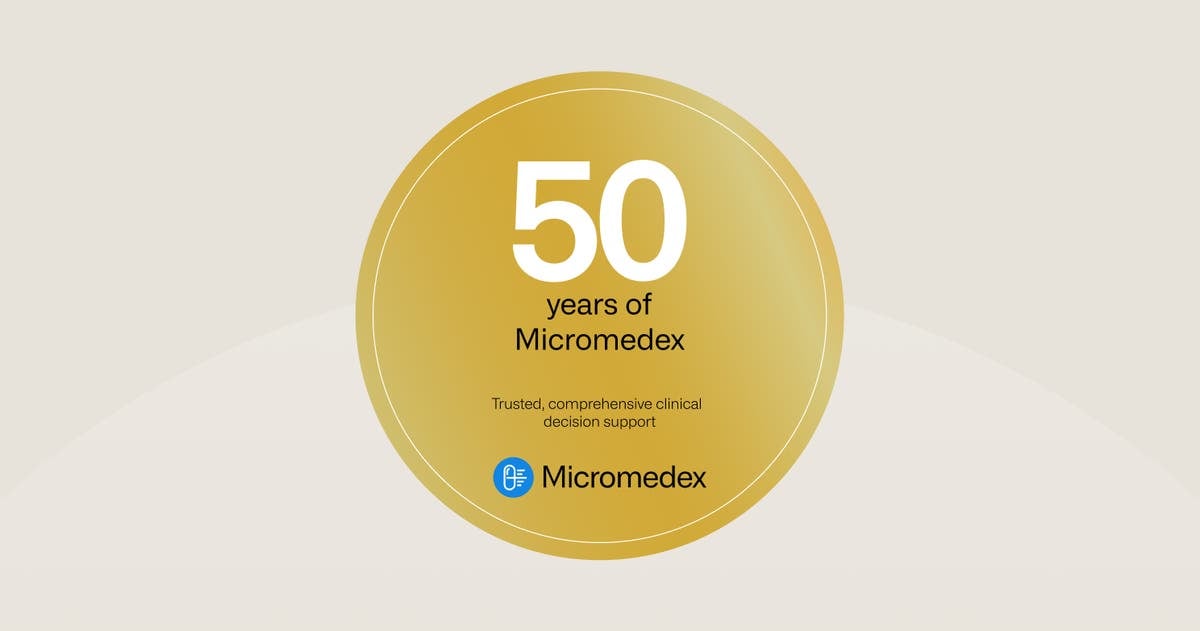3 reasons to prioritize integration of your clinical decision support tool into your electronic medical record (EMR)

Three award-winning hospitals see huge efficiency improvements, gain international accreditation, and build robust and rapid medication review processes by integrating evidence-based clinical information from Micromedex into their electronic medical record (EMR).
In busy hospitals, providing sophisticated medical care to hundreds of patients every day can be incredibly complex, and clinicians’ workloads are only expected to grow in the years ahead.
To ease the pressure and meet higher patient demand, many health centers are turning to technology to boost efficiency, improve patient safety and reduce costs. In fact, KLAS Research found in a recent survey that electronic medical record (EMR) digitalization was a key investment priority for 53 percent of healthcare organizations.1 In the survey, this category encompassed a wide range of topics including EMR selection, implementation and roll out, as well as patient engagement.
In many hospitals, doctors, pharmacists and nurses must often log into multiple different systems to access clinical decision support tools. In some cases, clinicians travel to separate parts of a ward or hospital just to access information on medication-related harm, which takes up valuable time in their workday and removes them from a patient’s bedside.
Furthermore, a shortage of skilled pharmacists in many countries means that some hospitals see the need to triage the clinical validation process by focusing on patients in the highest risk categories, such as those who take multiple medications or have a variety of health issues.
During peaks in demand, clinicians may resort to selectively reviewing prescriptions for only the most vulnerable patients, and some medication regimes therefore go unchecked. In addition to increasing the risk of potential medication-related harm, this approach can lead to inefficiencies. For instance, using expensive medications without review can lead to more cost-effective and appropriate alternative treatment methods being underutilized.
Integration boosts workflow efficiency
Easy, reliable and rapid access to clinical decision support tools is a vital ingredient in helping clinicians and hospitals to boost efficiency. With doctors, pharmacists, nurses, nutritionists and many other clinicians using an EMR every day, integrating clinical decision support tools into this core solution is a simple, effective way of providing information more quickly.
Christus Muguerza, an award-winning hospital network, issues thousands of prescriptions every day, and was looking for an innovative solution to amplify the reach of the clinical team and drive more efficient workflows. “Previously, our clinical pharmacy teams could spend hours reviewing one patient’s prescription, depending on the level of complexity,” reflects Antonio Dominguez Garza, Corporate Head of Pharmacy Informatics and Hospital Pharmacy at Christus Muguerza.
“With automated alerts from Micromedex, clinicians can work much faster because the clinical guidance they need is immediately available in their workflow in the EMR. Thanks to this, we can now process up to 160,000 prescriptions each month in each facility where Micromedex has been integrated. That’s a 5,300 percent increase — a scope that is only possible with this kind of digital transformation.”
– Antonio Dominguez Garza, Corporate Head of Pharmacy Informatics and Hospital Pharmacy at Christus Muguerza
Ranked ‘Best in KLAS 2023 for Clinical Decision Support: Point-of-Care Clinical Reference’, Micromedex seamlessly integrates with a wide range of EMR solutions to provide clinicians with instant access to the latest evidence-based information on medication. Some of the world’s leading medical institutions rely on Micromedex every day to aid their clinical decisions.
Leadership at TidalHealth Peninsula Regional, a non-profit hospital in Maryland, United States of America, ran a survey among its clinicians and found that 92% of respondents would be more likely to use a clinical decision support tool that was integrated into their EMR.
“Clinicians are under tremendous time pressure,” said Mark Weisman, MD, Chief Medical Information Officer at TidalHealth. “It’s important to streamline efficiencies where you can — and keep clinicians inside the workflows they are used to using. If they have to go outside those workflows to find information they need, that’s often a barrier to entry that may prevent them from getting it done.”
In the month following integration, TidalHealth Peninsula Regional clinicians used the Micromedex solution 489 times — compared to just 275 searches during the previous six months. And when Dr. Weisman and colleagues did time studies on the searches being conducted using Micromedex, they discovered that clinicians received their answers in less than one minute 73% of the time, compared to 3-4 minutes previously. These time efficiencies mean that clinicians can spend more time with patients for high quality care.
Automation can increase the scale of medication reviews and help to reduce medication errors
Patient safety is a priority for healthcare organizations, and clinicians in medication safety programs are acutely aware of the potential harm that could result from medication errors. Dangerous drug interactions, dosing errors and intravenous compatibility issues can cause harmful adverse events. Typically, patients with comorbidities and those who receive multiple medications face a higher risk.
Pharmacists at Hospital Internacional de Colombia (HIC), one of Colombia’s leading hospitals, have always conducted medication reviews to validate prescriptions for the most at-risk patient groups, helping them to maintain an excellent patient safety record. However, clinicians ran this process manually by proactively checking evidence-based resources for potential interactions or compatibility issues. While supporting excellent patient safety, working in this way took a significant amount of time and limited the number of clinical pharmacy validations that pharmacists could perform.
María Carolina Aguirre Navas, Chief Medical Information Officer at HIC, explains: “With 700 inpatient beds and many more outpatients, increasing the number of clinical pharmacy reviews that our team could carry out was a challenge. Skilled pharmacists are in short supply, so we looked at the possibility of partially automating clinical pharmacy validations to scale these interventions.”
Working with local integration partner Dot.lib, HIC integrated Micromedex® into the EMR, creating automated patient safety alerts directly within clinician workflows. The evidence-based clinical content of Micromedex is now available during prescription, dispensing and medication administration. As a result, clinical teams can evaluate drug interactions, maximum and minimum dosage considerations, and IV compatibility all within the EMR workflow. Moreover, the new solution automatically screens prescriptions for multiple medications as well as a patient’s clinical history and laboratory results to check for possible interactions.
“After integrating Micromedex into our EHR, we are now able to review 96 percent of the prescriptions that we issue. By reviewing almost all prescriptions, we are enabling better pharmacological treatment. We also expect to see significant improvements in pharmacokinetics and pharmacodynamics, as well as a reduction in medication errors. Most importantly, clinicians can now spend more time with patients instead of checking reference materials.”
– María Carolina Aguirre Navas, Chief Medical Information Officer at Hospital Internacional de Colombia
EMR digitalization supports international recognition and certification
For healthcare organizations that strive to provide truly world-class services, digital transformation focused on improving outcomes is a high priority. But extending digital infrastructure across health systems to advance performance can be a daunting task. Trusted frameworks such as HIMSS maturity models provide globally applicable standards for healthcare organizations to build their digital health ecosystems.
Access to critical information when and where clinicians need it is key criteria for achieving Stage 7 of the HIMSS Electronic Medical Record Adoption Model (EMRAM), the highest level an organization can achieve.
Integrating trusted clinical decision support from Micromedex into the EMR formed a key part of HIC’s strategic plan for digital transformation. The project helped HIC to achieve stage seven of the HIMSS EMRAM maturity model. Currently, only 6.4 percent of US hospitals have gained such a high level of certification2 and HIC is the first in the country to meet this maximum level of digital maturity.
“Achieving HIMSS EMRAM stage 7 certification is a huge milestone that we are incredibly proud of. We are committed to excellence, and by selecting award-winning solutions like Micromedex, we’re well placed to support continuous innovation and ensure that we always provide patients with the best possible care.”
– María Carolina Aguirre Navas, Chief Medical Information Officer at Hospital Internacional de Colombia
Additionally, accreditation from organizations such as the Joint Commission International (JCI) recognizes efforts in continuously improving and implementing best practices, and rewards healthcare providers for achieving peak performance. Patient safety in relation to prescribing and administering medicines is an important factor in qualifying for JCI accreditation, as is risk management; hospitals must have an ongoing process to identify and reduce adverse events.
Already an award-winning institution, Christus Muguerza anticipates that the benefits seen from embedding Micromedex into its EHR will help the organization to achieve further international certifications and accreditations. “Christus Muguerza Alta Especialidad Hospital was the first hospital in Mexico to receive accreditation from the Joint Commission International,” says Garza. “We’re very proud of this achievement, but we want to go even further. Enhancing clinician workflows with best-in-class solutions like Micromedex will help us to gain the international recognition that our clinicians deserve for their excellent work.”
These two prominent hospitals in Latin America recently took a huge step forward on their digital transformation journey by integrating Micromedex in the EMR, to support clinical decision making when prescribing, reviewing and administering medications.
Conclusion
As these hospitals demonstrate, bringing clinical decision support solutions to clinicians at the point of care improves efficiency, both for individual clinicians and entire hospital networks. EMR integration is an important part of digital strategy and it played a key part in these organizations achieving international recognition and accreditation.
Most importantly, automating manual clinical information review processes allows teams to increase the scale of vital activities, such as clinical pharmacy validations, and helps to reduce medication errors and take excellent patient safety records to new highs. All this releases doctors, nurses and specialists to spend more time on active listening and delivering outstanding patient-centered care services.
Learn more about how Christus Muguerza stepped up digital transformation by integrating Micromedex® into the Philips Tasy EMR to help prevent patient harm.
Learn more about how HIC integrated Micromedex® into its EMR for an automated warning system directly in the workflow for physicians, pharmacists and nurses.
Learn more about how EMR integration delivered staggering results for TidalHealth Peninsula Regional.
To find out more about Micromedex, please visit merative.com/clinical-decision-support for more information.
References
- Santos, Everton & Christensen, Jonathan, “Global (Non-US) Healthcare IT Trends 2023: Understanding Organizations’ IT Priorities Pre- and Post-Pandemic,” KLAS Research, March 2023.
- Jessica Kim Cohen, “How many hospitals are on each stage of HIMSS Analytics' EMR Adoption Model?”, Beckers Health IT, April 2018.
Related Articles

50 years of Micromedex – a celebration of our history
Since the mid 1970s, Micromedex has been a pioneer in evidence-based clinical...
By Merative | 7 min. read

The cost of patient safety: 3 considerations for hospital leadership on clinical decision support investments
Clinical decision support systems come at a cost, but of course are critical to...
By Merative | 5 min. read

Tackling avoidable harm in vulnerable populations
How can clinicians ensure patient safety when prescribing medication for elderly...
By Gavin McNatt Pharm.D. | 7 min. read
Ready for a consultation?
Our team is ready to answer your questions. Let's make smarter health ecosystems, together.
